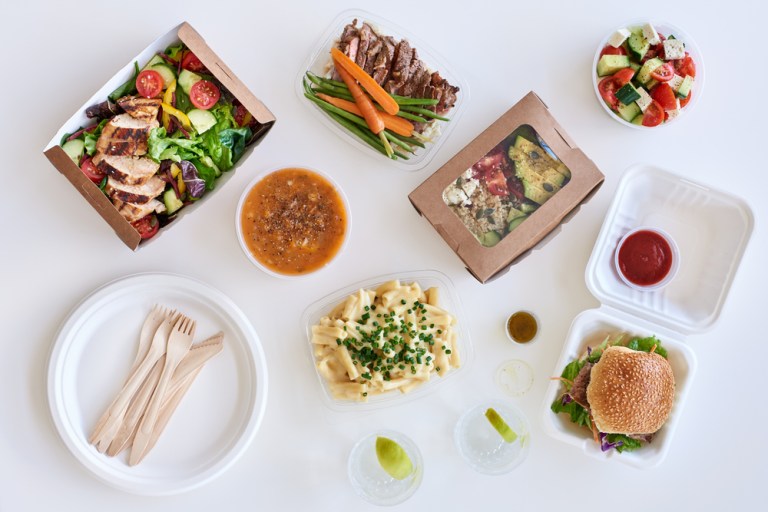
Food delivery is moving into a higher realm, one that is about much more than ordering up a meal via a mobile app. Subscriptions are winning over hungry consumers. Local focus is entering the mix. Drones are getting involved.
And big money is flowing as competitors seek to differentiate themselves in the $13 billion food delivery business.
Earlier this week, Postmates, the on-demand delivery company, said it has raised $300 million in venture funding — the investment coming off a record year of growth, market expansion and adoption of a subscription service. Postmates said it completes millions of deliveries each month, generates more than a billion dollars in gross merchandise volume annually and is profitable in 90 percent of the markets in which it operates.
Delivery Subscriptions
Its subscription service is catching on with consumers and could foreshadow future developments in the food delivery business. Consumers who pay $9.99 per month get unlimited free deliveries. The number of those Unlimited subscribers has doubled so far from last year and has grown by 300 percent year over year, with one in two orders on the platform placed via Unlimited, across multiple markets.
Rivals are embracing subscriptions too. Over the summer, DoorDash launched a service called DashPass. A consumer paying $9.99 per month also gets unlimited free deliveries — this and from the likes of Wendy’s, The Cheesecake Factory, California Pizza Kitchen, White Castle and others.
Partnerships, too, are emerging as a way for food delivery services to make their marks. After all, not all QSRs and other eateries want to invest time and money developing their own delivery system and technology. For example, DoorDash has inked relationships with IHOP, White Castle and Red Lobster, among others, for delivery services.
The danger there is being too aggressive, as DoorDash learned. It was apparently offering delivery without some restaurants’ knowledge, and that led to complaints and resentment whenever food did not show up.
Better Tech
Technology, too, represents a way for Postmates and others to stand apart in a crowded field. The new Postmates capital will go to, among other areas, what the company called “state-of-the-art API tools,” which, in turn, will contribute to white-glove delivery services. Postmates also plans to invest in “new, last-mile mobility solutions,” it said. All that is happening as the industry races to make food delivery transactions as seamless and with as little friction as possible — hungry consumers are impatient consumers.
“What we’ve seen in the past couple years — and specifically in the last year — is a real shift in investor and analyst mindset around the space. There’s a growing consensus that the market opportunity is bigger than ridesharing, and the margins are better,” Kristin Schaefer, Postmates chief financial officer, told a reporter.
The drive to stand apart from the crowd applies to smaller food delivery operators too. In Richmond, Virginia, for example, Chop Chop allows diners to choose from a menu of 50 to 60 restaurants for delivery.
The value proposition?
Because the service is local and has close relationships, companies such as Chop Chop can work with restaurant owners and talk with them about their needs, what makes them unique and what Chop Chop can do in terms of getting the word out about their establishments. “We’re there to market for them to help them grow,” Chop Chop wwner Chris Chandler said in a recent PYMNTS interview.
Make no mistake: Local counts when it comes to commerce. You can find proof of that from the biggest operators. That includes Amazon, which recently made a deal with Yext, a company that deals in location data and associated services — a relationship designed to beef up the local merchant knowledge on Alexa.
Payment Integration
Maybe local is a way to help a company survive or carve a profitable niche in a food delivery world where Uber Eats is the fastest-growing such service in the United States, beating out Grubgub. Not that Uber is standing on its food delivery laurels. It’s recently launched Uber Cash is designed, via closed-loop payments (at least for now), to tie together the expanding Uber ecosystem, which could discourage consumers from using rival operations.
As for Grubhub, it is also hoping that integration leads to growth in this increasingly crowded and lucrative field of food delivery. Earlier this year, it added Venmo to its platform, meaning consumers will have an easier way to share the cost of a delivery order with friends. Think of that late-night pizza order, for instance — instead of digging around for cash, or having that one pal break out his credit card, that meal can be split among the group.
Food from the Sky
Drones, too, seem likely to play more of a role in food delivery.
Evidence of that comes from North Carolina (home of the first manned airplane flight) and drone delivery company Flytrex. Under the drone delivery model, customers order food through a restaurant’s app and runners take the meal to a central drone launch location. From there, the drone will fly to the customer’s home and can be tracked via an app. Flytrex’s drones can carry a 6lb. package for 3 miles and arrive in five to 10 minutes, Yariv Bash, CEO of Flytrex, told PYMNTS.
Food delivery is, perhaps, an odd service, given that its success relies in no small part on products made by others (that is, the restaurant, as many consumers will not separate its work from the delivery). But as more consumers decide to eat at home and technology makes more deliveries possible, you can bet on more effort from those delivery providers to differentiate themselves and attract more investment and customers.